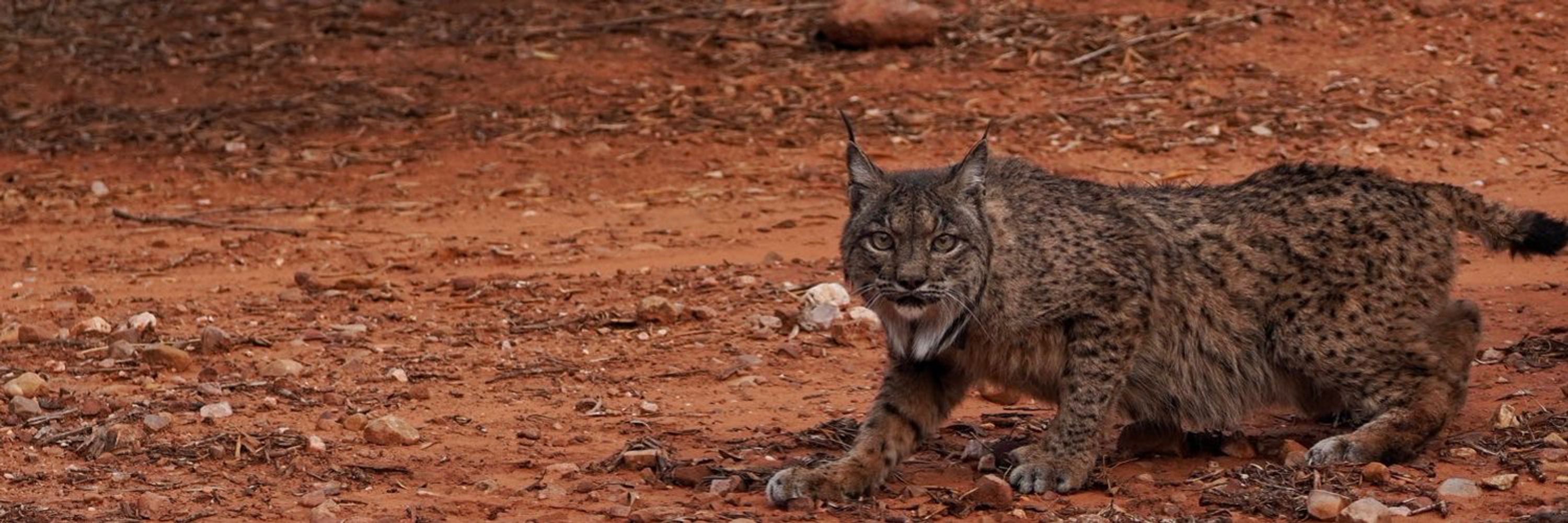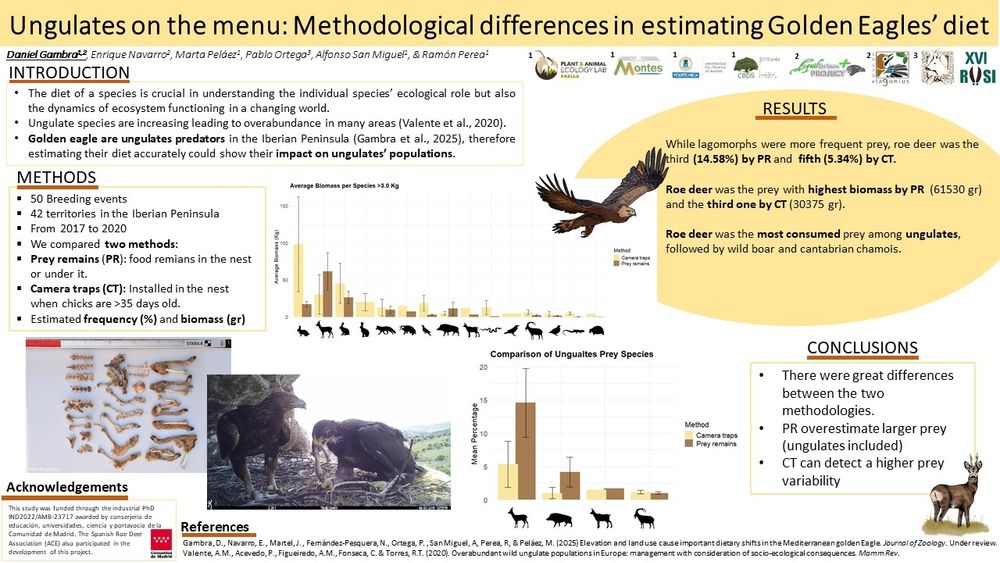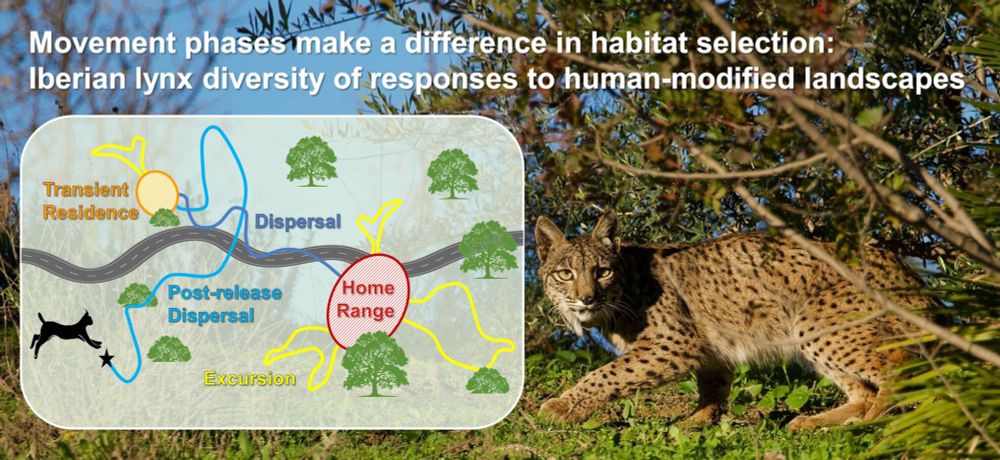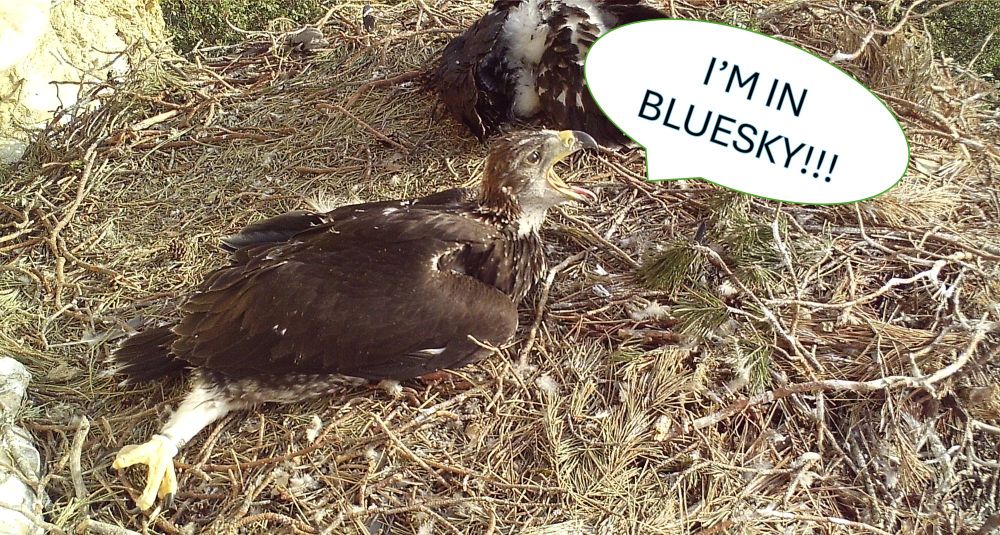
Pablo Cisneros Araujo
@pabcis.bsky.social
Interested in Movement Ecology, Biodiversity Conservation, Rewilding.
Postdoc at FPNCYL & UPM
Postdoc at FPNCYL & UPM
Not all Iberian lynx movements are the same 🐾
Using GPS data of 124 lynxes we found that:
-Resident lynxes avoided human areas
-Dispersers tolerated crossing them
-Reintroduced lynxes were particularly cautious in their new environments
A remarkable plasticity for living in heterogeneous landscapes
Using GPS data of 124 lynxes we found that:
-Resident lynxes avoided human areas
-Dispersers tolerated crossing them
-Reintroduced lynxes were particularly cautious in their new environments
A remarkable plasticity for living in heterogeneous landscapes
🚨 new research: "movement phases make a difference in habitat selection: Iberian lynx diversity of responses to human-modified landscapes"
📝 read the full paper here: buff.ly/T24zHuT
@santiagosaura.bsky.social @pabcis.bsky.social @aitorgaston.bsky.social
📝 read the full paper here: buff.ly/T24zHuT
@santiagosaura.bsky.social @pabcis.bsky.social @aitorgaston.bsky.social

July 25, 2025 at 7:45 AM
Not all Iberian lynx movements are the same 🐾
Using GPS data of 124 lynxes we found that:
-Resident lynxes avoided human areas
-Dispersers tolerated crossing them
-Reintroduced lynxes were particularly cautious in their new environments
A remarkable plasticity for living in heterogeneous landscapes
Using GPS data of 124 lynxes we found that:
-Resident lynxes avoided human areas
-Dispersers tolerated crossing them
-Reintroduced lynxes were particularly cautious in their new environments
A remarkable plasticity for living in heterogeneous landscapes
Reposted by Pablo Cisneros Araujo
In #XVIRUSI in Portugal I presented the differences estimating Golden Eagles' diet by prey remains vs camera traps. #RaptorResearch
Prey remains overestimate big prey (e.g. roe deer) and camera traps detect better reptiles. @paellalab.bsky.social
Prey remains overestimate big prey (e.g. roe deer) and camera traps detect better reptiles. @paellalab.bsky.social

July 15, 2025 at 7:37 AM
In #XVIRUSI in Portugal I presented the differences estimating Golden Eagles' diet by prey remains vs camera traps. #RaptorResearch
Prey remains overestimate big prey (e.g. roe deer) and camera traps detect better reptiles. @paellalab.bsky.social
Prey remains overestimate big prey (e.g. roe deer) and camera traps detect better reptiles. @paellalab.bsky.social
Reposted by Pablo Cisneros Araujo
El lince ibérico, ¿por dónde se mueve y qué hábitats prefiere?
Respondemos diferenciando sus preferencias en las áreas de campeo, residencias transitorias, excursiones y dispersiones.
Analizando los datos proporcionados por 124 linces con collares GPS.
Recién publicado.
doi.org/10.1111/1365...
Respondemos diferenciando sus preferencias en las áreas de campeo, residencias transitorias, excursiones y dispersiones.
Analizando los datos proporcionados por 124 linces con collares GPS.
Recién publicado.
doi.org/10.1111/1365...

Movement phases make a difference in habitat selection: Iberian lynx diversity of responses to human‐modified landscapes
By examining habitat selection across five movement phases in the reintroduced Iberian lynx, our study reveals high behavioural plasticity and key differences between and among resident and non-resid...
doi.org
July 8, 2025 at 8:18 AM
El lince ibérico, ¿por dónde se mueve y qué hábitats prefiere?
Respondemos diferenciando sus preferencias en las áreas de campeo, residencias transitorias, excursiones y dispersiones.
Analizando los datos proporcionados por 124 linces con collares GPS.
Recién publicado.
doi.org/10.1111/1365...
Respondemos diferenciando sus preferencias en las áreas de campeo, residencias transitorias, excursiones y dispersiones.
Analizando los datos proporcionados por 124 linces con collares GPS.
Recién publicado.
doi.org/10.1111/1365...
Reposted by Pablo Cisneros Araujo
The Iberian lynx habitat selection: we show how it depends on lynx movement phases.
Separately considering home ranges, transient residences, excursions, post-release dispersals and dispersals.
Analysing a large GPS telemetry dataset from 124 lynxes.
Just published.
doi.org/10.1111/1365...
Separately considering home ranges, transient residences, excursions, post-release dispersals and dispersals.
Analysing a large GPS telemetry dataset from 124 lynxes.
Just published.
doi.org/10.1111/1365...

Movement phases make a difference in habitat selection: Iberian lynx diversity of responses to human‐modified landscapes
By examining habitat selection across five movement phases in the reintroduced Iberian lynx, our study reveals high behavioural plasticity and key differences between and among resident and non-resid...
doi.org
July 8, 2025 at 8:31 AM
The Iberian lynx habitat selection: we show how it depends on lynx movement phases.
Separately considering home ranges, transient residences, excursions, post-release dispersals and dispersals.
Analysing a large GPS telemetry dataset from 124 lynxes.
Just published.
doi.org/10.1111/1365...
Separately considering home ranges, transient residences, excursions, post-release dispersals and dispersals.
Analysing a large GPS telemetry dataset from 124 lynxes.
Just published.
doi.org/10.1111/1365...
Reposted by Pablo Cisneros Araujo
El Hayedo de Montejo: la investigación como base para su gestión.
Este es el objeto de la jornada que se celebrará este miércoles 19 de marzo en la Escuela Técnica Superior de Ingeniería de Montes, Forestal y del Medio Natural de la @upm.es.
Este es el objeto de la jornada que se celebrará este miércoles 19 de marzo en la Escuela Técnica Superior de Ingeniería de Montes, Forestal y del Medio Natural de la @upm.es.

March 16, 2025 at 6:08 PM
El Hayedo de Montejo: la investigación como base para su gestión.
Este es el objeto de la jornada que se celebrará este miércoles 19 de marzo en la Escuela Técnica Superior de Ingeniería de Montes, Forestal y del Medio Natural de la @upm.es.
Este es el objeto de la jornada que se celebrará este miércoles 19 de marzo en la Escuela Técnica Superior de Ingeniería de Montes, Forestal y del Medio Natural de la @upm.es.
Reposted by Pablo Cisneros Araujo
Comenzamos el proyecto SafeNet del Horizonte Europa con el objetivo de contribuir a salvaguardar la biodiversidad y la capacidad de adaptación de los bosques europeos.
Mediante el trabajo conjunto de 14 socios europeos.
Más información en @safenet-eu.bsky.social y cordis.europa.eu/project/id/1....
Mediante el trabajo conjunto de 14 socios europeos.
Más información en @safenet-eu.bsky.social y cordis.europa.eu/project/id/1....




March 2, 2025 at 11:14 AM
Comenzamos el proyecto SafeNet del Horizonte Europa con el objetivo de contribuir a salvaguardar la biodiversidad y la capacidad de adaptación de los bosques europeos.
Mediante el trabajo conjunto de 14 socios europeos.
Más información en @safenet-eu.bsky.social y cordis.europa.eu/project/id/1....
Mediante el trabajo conjunto de 14 socios europeos.
Más información en @safenet-eu.bsky.social y cordis.europa.eu/project/id/1....
Many small cat reintroduction initiatives are happening or under consideration worldwide: wildcats (Scotland), ocelots (Argentina & USA), southern tiger cats & margays (Brazil), black-footed cats (South Africa), clouded leopards (Taiwan) & flat-headed cats (Thailand).
Understanding what can make small cat reintroductions successful: Reintroducing small #wildcats plays a crucial role in restoring #ecosystems and combating #biodiversity loss.
news.mongabay.com/2025/02/gett...
news.mongabay.com/2025/02/gett...

Getting rewilding right with the reintroduction of small wildcats
For the briefest moment earlier this year, the Eurasian lynx — extinct in the U.K. for thousands of years — returned to the wild in Scotland. But this release wasn’t scientifically planned. Rather, it...
news.mongabay.com
February 20, 2025 at 10:29 PM
Many small cat reintroduction initiatives are happening or under consideration worldwide: wildcats (Scotland), ocelots (Argentina & USA), southern tiger cats & margays (Brazil), black-footed cats (South Africa), clouded leopards (Taiwan) & flat-headed cats (Thailand).
Reposted by Pablo Cisneros Araujo
Thrill to start sharing news about golden eagles and other raptors' ecology.
And other wildlife too... 🦅🦏🦉🦍
And other wildlife too... 🦅🦏🦉🦍

February 19, 2025 at 12:27 PM
Thrill to start sharing news about golden eagles and other raptors' ecology.
And other wildlife too... 🦅🦏🦉🦍
And other wildlife too... 🦅🦏🦉🦍
Reposted by Pablo Cisneros Araujo
¡Celebramos la introducción de dos nuevas poblaciones de #lince ibérico en #Cuenca y #Palencia!
📍 Estas poblaciones, junto a las creadas recientemente en #Murcia y #Granada, acercan el objetivo de 750 hembras y 3.000-3.500 ejemplares para considerar al lince fuera de peligro.
📍 Estas poblaciones, junto a las creadas recientemente en #Murcia y #Granada, acercan el objetivo de 750 hembras y 3.000-3.500 ejemplares para considerar al lince fuera de peligro.

February 17, 2025 at 11:02 AM
¡Celebramos la introducción de dos nuevas poblaciones de #lince ibérico en #Cuenca y #Palencia!
📍 Estas poblaciones, junto a las creadas recientemente en #Murcia y #Granada, acercan el objetivo de 750 hembras y 3.000-3.500 ejemplares para considerar al lince fuera de peligro.
📍 Estas poblaciones, junto a las creadas recientemente en #Murcia y #Granada, acercan el objetivo de 750 hembras y 3.000-3.500 ejemplares para considerar al lince fuera de peligro.
India has "75% of the world’s tigers, despite having just 18% of the global tiger habitat".
From less than 1,500 tigers in 2006 to 3,682 currently. Nearly 50% inhabiting human multiple-use habitats, home to 60m people.
archive.is/7B59p
www.science.org/doi/10.1126/...
From less than 1,500 tigers in 2006 to 3,682 currently. Nearly 50% inhabiting human multiple-use habitats, home to 60m people.
archive.is/7B59p
www.science.org/doi/10.1126/...
From @theeconomistevents.bsky.social, “India’s attempt to save the tiger has been a remarkable success.” 🌍🧪🐅
www.economist.com/asia/2025/02...
www.economist.com/asia/2025/02...

India’s attempt to save the tiger has been a remarkable success
The predator is now thriving in many parts of the country, even alongside humans
www.economist.com
February 16, 2025 at 4:37 PM
India has "75% of the world’s tigers, despite having just 18% of the global tiger habitat".
From less than 1,500 tigers in 2006 to 3,682 currently. Nearly 50% inhabiting human multiple-use habitats, home to 60m people.
archive.is/7B59p
www.science.org/doi/10.1126/...
From less than 1,500 tigers in 2006 to 3,682 currently. Nearly 50% inhabiting human multiple-use habitats, home to 60m people.
archive.is/7B59p
www.science.org/doi/10.1126/...
Reposted by Pablo Cisneros Araujo
"New research reveals how predators and prey adjust their behaviours in space and time! 📷 Using camera-trap data from Brazil and Suriname, we found that red-rumped agoutis adjust their activity patterns in response to ocelots' presence."
buff.ly/40QU0hz
buff.ly/40QU0hz

February 13, 2025 at 4:58 PM
"New research reveals how predators and prey adjust their behaviours in space and time! 📷 Using camera-trap data from Brazil and Suriname, we found that red-rumped agoutis adjust their activity patterns in response to ocelots' presence."
buff.ly/40QU0hz
buff.ly/40QU0hz

